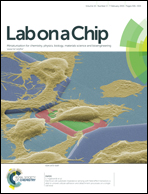Lab-in-a-tube systems as ultra-compact devices
Abstract
In this Focus article, I will give an overview on the current and future interests of our multidisciplinary research group. One of our main interests is to develop highly integrated on-chip components towards ultra-compact devices for biosensing technologies (lab-in-a-tube). Our other activities are focused in developing self-powered devices that can generate either motion of a fluid or autonomous propulsion. We are particularly interested in three-dimensional (3D) nanofabrication technologies and stimuli responsive soft materials.


 Please wait while we load your content...
Please wait while we load your content...